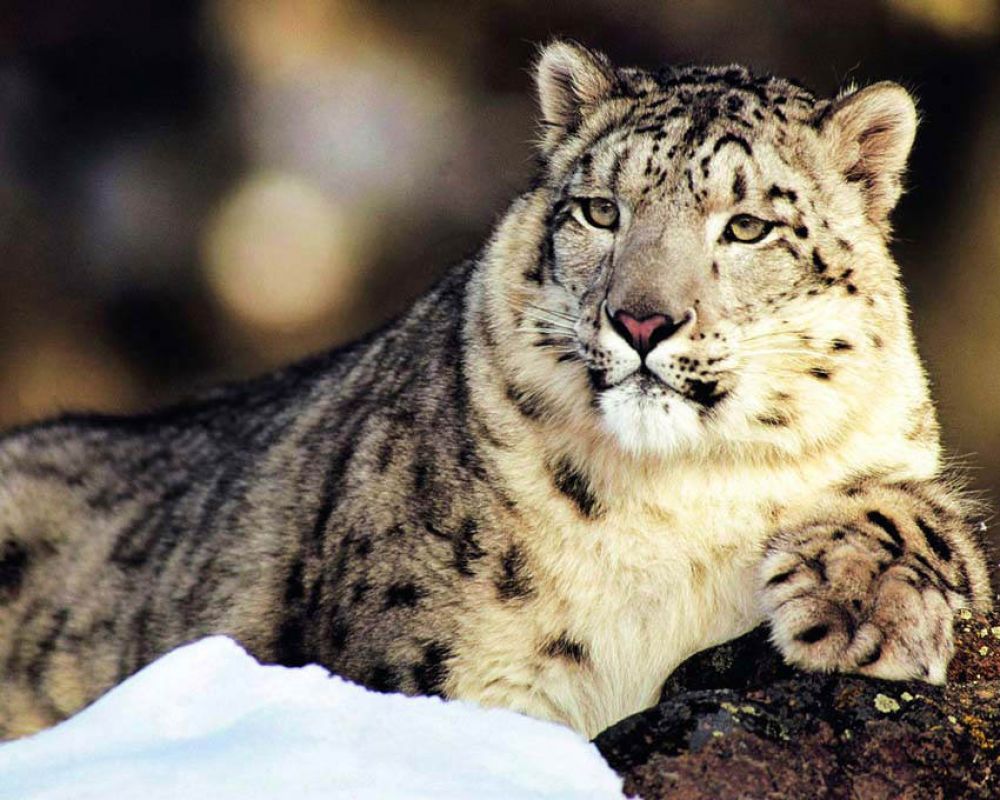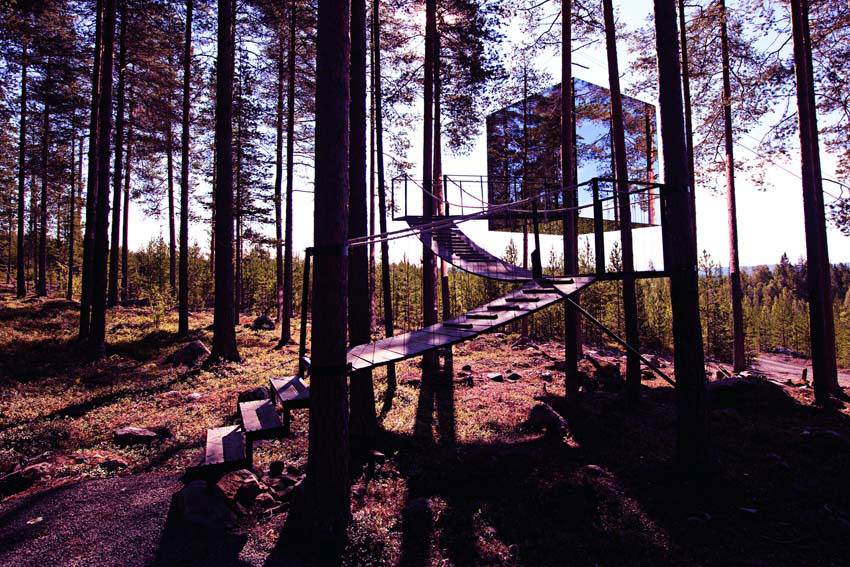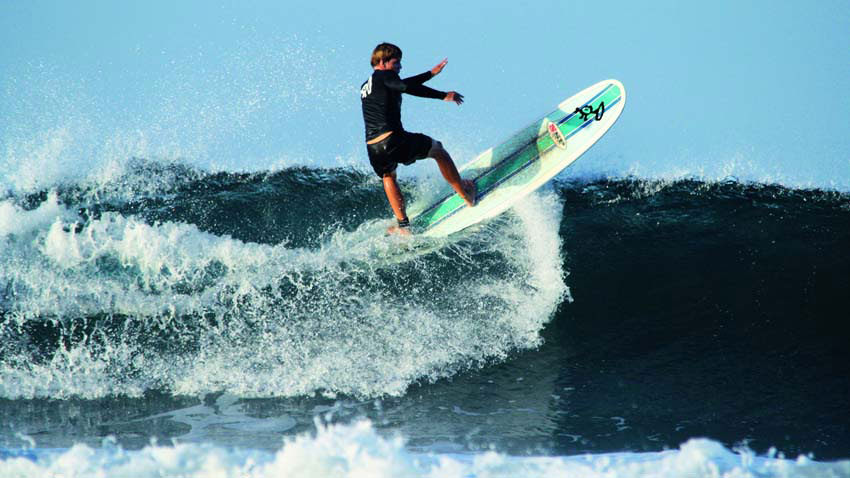Off the beaten track
Had your fill of lazy holidays? Stuck in a rut and fancy something a bit different this year? Look no further, as Katrina Hendley offers some inspiration for more adventurous summer breaks.

Had your fill of lazy holidays? Stuck in a rut and fancy something a bit different this year? Look no further, as Katrina Hendley offers some inspiration for more adventurous summer breaks.
As if staying in light-reflecting cube wasn’t novelty enough, this one’s up a tree. But before your inner child gets too carried away; let me explain that this treehouse is, in fact, a sophisticated concept: think art installation in a serene forest and you won’t be far wrong.
Treehotel opened last year in Harads, a small village in the north of Sweden about 100km from Lulea Airport and the same distance from the Arctic Circle. The invisible cube – or The Mirrorcube, to give it its proper name – is built high up in a natural pine forest and completely covered in mirrors to reflect the surrounding trees and sky, giving the effect of disappearing into the landscape. And what a landscape it is – you’re surrounded by miles of centuries-old pines, with spectacular views over the Lule river valley and its surging current. The long days of summer – it barely gets dark this far north – mean you’ll have plenty of time to revel in unspoiled nature.
The Mirrorcube is one of five treerooms, each designed by a different Scandinavian architect. While all of them are contemporary creations, the similarity stops there. You can also choose from The Bird’s Nest, The Cabin, The UFO, and The Blue Cone – and there are plans for 19 more, which are sure to be suitably different.
Remarkably, there’s also a nearby tree sauna holding up to 12 sweaty people, while meals are taken in the fabulous 1930s–1950s retro-themed Britta’s guesthouse where you check in, a five-minute stroll away. Treehotel founders Britta and Kent Lindvall set out to create a place in which nature, comfort and modern design merge to create a harmonious environment, and they’ve clearly succeeded. The local area offers plenty of seasonal activities including sledding, fishing and kayaking, but the whole point of this unique place is to recharge your batteries in the peace of the forest.

A night in the Treehotel’s Mirrorcube (00 46 928 104 03, http://treehotel.se) costs £400 and includes breakfast for two. Other
meals are also available in the Britta’s guesthouse.
Peru is virtually synonymous with Machu Picchu, and with good reason. But a country this full of archaeological and natural wonders has many more adventures up its sleeve – including mountain biking in the Sacred Valley of the Incas. The Sacred Valley lies beneath Machu Picchu and cradles Inca ruins along with small villages, fertile plains and the sacred Rio Urubamba. Now becoming a destination in its own right, it deserves a leisurely pace, so a bike ride is perfect for absorbing its views.
The route starts off with a dirt road descending from Chinchero Plain, past Lake Huaypo – renowned for UFO sightings – with superb views of the white Vilcanota mountain range and down into the Sacred Valley. Passing through the small village of Chequereq, where Andean life continues pretty much as it has for the last 500 years, you’ll pick up a rarely used dirt trail towards the circular Inca ruins of Moray – a perfect spot for lunch.
Refuelling is likely to entail deliciously portable butifarras, a sandwich of spiced Peruvian ham and salsa criolla (thinly sliced red onions, coriander, chilli and lime).
Next, it’s time to hit the mule trail that heads to Maras and its terraced salt pans, still in use after 600 years. Salt water from the Qoripujio spring is channelled through shallow, manmade terraces where evaporation spawns a generous salt harvest. It’s a dramatic sight with over 3,000 pools crammed into a single vertiginous valley.
One of the great things about this trip, aside from the views, history and the insight into Peruvian life, is that it can be adapted to suit all ages and abilities. Cycling to Machu Picchu, however, might be a different matter.

This bike trip is included in the Peru Air and
Space family adventure with Powder Byrne (020 8246
5300, powderbyrne.com). The nine-day trip costs from
£2,323 per adult – excluding flights.
Bosnia and Herzegovina is still emerging as a holiday destination – and its reputation as a year-round adventure playground is also growing fast. Home to the magnificently spiky peaks of the Dinaric Alps, pristine freshwater rivers winding through limestone gorges, huge national parks and one of Europe’s last primeval forests, it’s no wonder
that skiers, mountain bikers, hikers, rafters and climbers have got Bosnia on their radar.
Of all the options in this rugged landscape, negotiating your way down a ribbon of water through untouched canyons offers some of the best views, along with some of the tastiest whitewater rafting in Europe. Head to the emerald green Neretva river, which flows from the Alps down to the Adriatic Sea, carving deep gorges through the Eastern Bosnian limestone en route. The water is relatively calm this time of year, so you’ll have plenty of opportunity to float through canyons with waterfalls, beaches and lush greenery; watching eagles circling above. More energetically, there’s also a glorious rush in spotting the regular stretches of white foam and paddling towards them for guaranteed adrenaline as you steer through rapids or around rocky outcrops. As well as the Neretva, there’s also the Tara river, which borders Montenegro and flows through Europe’s largest canyon; the Vrbas and Una rivers, which take you through forests, meadows and hills bordering Croatia.

Oars (oars.com) has launched the Bosnia and Herzegovina Three Rivers Adventure. The nine-day trip costs £1,877 per adult, excluding flights, or book while you are there with Green Visions (http://greenvisions.ba) which offers a day’s rafting on the Neretva from Konjic from around £50.
Costa Rica is a legendary surfing destination among those in the know – all those consistent rolling waves, all that raw beauty. No one could call its beaches crowded, but if you’re really serious about getting away from it all – without sacrificing world-class surf – now’s a great time to head for Nosara, a small town tucked away on the Nicoya Peninsula.
It’s all about lush tropical rainforest and beautiful, white sand, with a rustic, laid-back vibe that tends to attract surfers, artists and yoga enthusiasts. Even better, the coastline is a conservation reserve so no big developments or deforestation. Instead you’ll find real jungle and one of the country’s most diverse ecological environments, home to a turtle refuge as well as exotic birds, howler monkeys, armadillos and raccoons among many other species. Playa Guiones offers more than three miles of sandy-bottomed breakers and consistently good surf year-round for all levels.
Nosara’s remote location ensures it’s never too busy, but go now, when a lot of tropical coasts are hammered by downpours, and it should be blissfully tranquil. In fact, you’ll hit the region’s ‘veranillo’, or ‘little summer’, a few weeks in the middle of the rainy season when it’s dry and the offshore winds pick up again. Just don’t tell anyone.

A seven-day surf coaching package at all inclusive
resort Surf Simply (http://surfsimply.com) starts from £1,600 and includes airport transfers.
An active volcano is about as close as we get to the raw power that shaped our planet. Perhaps that’s their magnetic attraction – and why climbing one is truly a walk on the wild side.
Fany joining the red hot lava club? Then Indonesia, home to more active peaks than any other country, is the place to go. And Lombok’s Mount Rinjani is a fine choice, looming majestically over the island to offer a compelling combination of mind-blowing views and challenging treks. The walk up takes you through fertile fields of coffee, cinnamon and cotton before hitting grassland and rainforest with orchids, edelweiss, black monkeys and deer among the many distractions along the way. But the real goals are its fascinating crater rim at 2,700m and the peak at 3,726m.
Rinjani’s huge crater is renowned for its crescentshaped lake, Segara Anak or ‘child of the sea’. In its centre lies a highly active micro peak, Gunung Baru – a new cone that spews out spectacular displays of steam. With caves, waterfalls and hot springs nearby, there’s plenty to see even if you can’t face the final ascent up to the peak and the jaw-dropping panorama of Lombok and its surrounding islands. You probably don’t need us to tell you that it’s worth the effort.

World Expeditions (http://worldexpeditions.co.uk) offer a 15-day trip that takes in four volcanoes and costs £1,790 per person, excluding flights.
Deep in the heart of central Asia, bordered by China, Mongolia, Kazakhstan, Russia and the Tuva Republic, are the Altai Mountains. If you’ve never heard of them, it’s because this region is one of the most remote, unspoilt and least visited parts of the world. In short it’s the perfect habitat for the elusive snow leopard. The silver-coated cats have long, thick fur prized by poachers and their numbers have been decimated to around 6,000. More data on these endangered leopards is needed before a conservation management plan can be drawn up – and that’ s where you come in. You can help with the research while also enjoying access to an area few foreigners reach. As part of a working conservation holiday, you’ll track the snow leopards’ movements and their prey, such as the argali mountain sheep and the Altai ibex, as well as birds, butterflies and bats. This is a genuine scientific expedition so accommodation is not exactly five star. That said, it’s not boot camp either – base camp is a huddle of sophisticated tents at 2,200m set amid larch forest overlooking the Jyelo river and surrounded by flower meadows, mountains, cliffs and glaciers. If you’d like an adventure with a sense of purpose, look no further.

A two-week trip with Biosphere Expeditions (http://biosphere-expeditions.org.uk) to the Altai Republic costs £1,580 per person, excluding flights.
Subscribe and view full print editions online... Subscribe